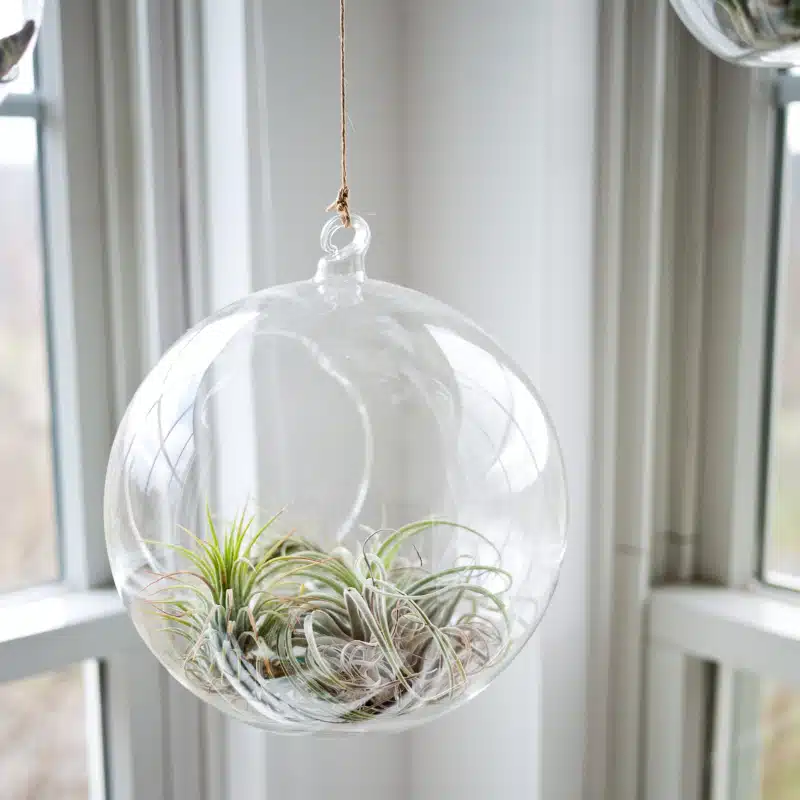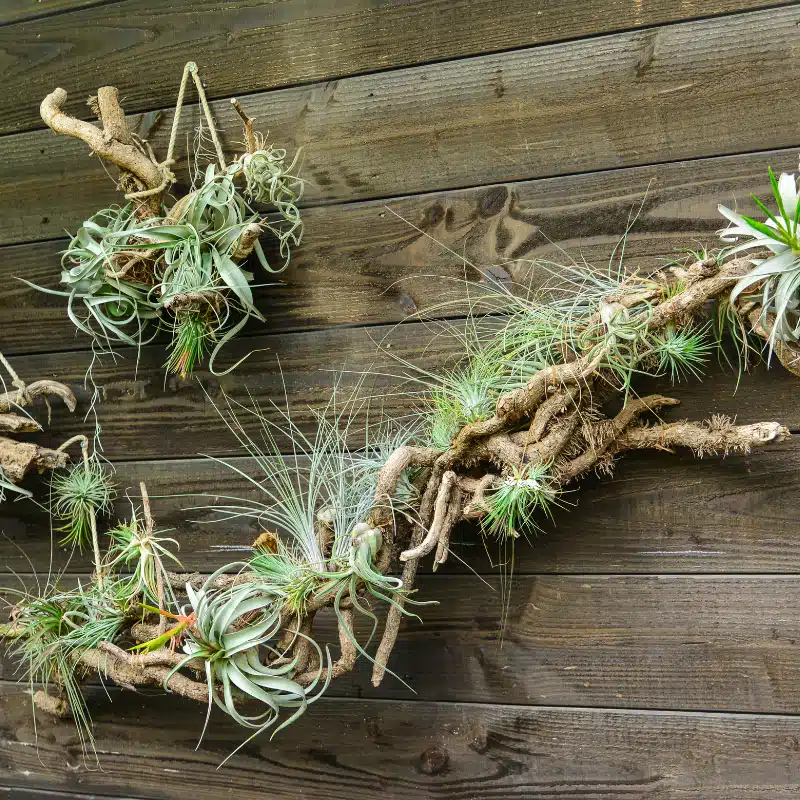The benefits of air plants should not be overlooked – they are ideal house plants and provide tons of health benefits!
Furthermore, they are great for your self-care routine! You can spend time taking care of them and create a beautiful space that is stress-free. The health benefits of air plants coupled with the ability to add them to your self-care routine, make them priceless additions to your home!
Plus, you don’t need a green thumb to keep them alive. By adding air plants to your home, you’ll experience fresh oxygen and a peaceful environment. Not to mention, you’ll have a ton of cute little things (these plants) all over your home!
Self Care and Plants – A Perfect Match
There are many ways in which plants can contribute to self-care. Some of the benefits of plants for self-care include:
- Stress reduction: Research has shown that being around plants can help to reduce stress. Additionally, they may reduce anxiety and can improve overall well-being.
- Improved air quality: Many plants are able to purify the air and remove toxins. This can help to improve indoor air quality and contribute to better health.
- Increased productivity: Studies have shown that being around plants can improve focus and concentration, leading to increased productivity.
- Improved mood: Being around plants has been shown to improve mood. Subsequently, this can help to reduce feelings of sadness, loneliness, and frustration.
- Relaxation: Taking care of plants and spending time in nature can be relaxing. If you read our article on tree therapy, you know that spending time around plants has tons of benefits.
- A zen space: Adding plants to your home or bedroom is so visually appealing. It will provide the perfect aesthetic for any room in your home.
By incorporating plants into your self-care routine, you can enjoy the many benefits they have to offer. Additionally, this will help to improve your overall well-being.
Air plant care is self care! Now, let’s talk about air plants.
Air plants 101:
Air plants, also known as tillandsia, are a unique type of plant that does not require soil to grow and thrive. Consequently, they only need … air!
These versatile houseplants can be found in a range of environments, from tropical rainforests to desert regions. They are known for their ability to absorb moisture and nutrients from the air through their leaves. They actually have scales that allow them to do so!
This makes them a great option for people who may not have a green thumb or for those who don’t have the time or space for a garden. You can create your own low-maintenance indoor garden in no time!
Air plants may be confused with succulents but they are not the same. Some common types of air plants that you may be familiar with are Spanish Moss and Spider Plants.
Benefits of Air Plants
One of the main benefits of air plants is their low maintenance requirements. They only need water misting or soaking to provide them with the moisture they need to survive.
Air plants are also known for their aesthetic appeal. These plants come in a range of shapes, sizes, and colors, and can add a unique touch to any living space. They can be displayed on their own, in a terrarium, or even suspended in the air with the help of a decorative hanger.
Another health benefit is their ability to improve air quality. These plants are natural air purifiers and can help to remove toxins and pollutants from the air. They can also increase the humidity in a space, which can be beneficial for people with respiratory issues or dry skin.
Air plants are also versatile and can be used in a variety of ways. They can be incorporated into home decor, used in DIY projects, or even given as gifts. They can also be used in culinary applications, such as adding a decorative touch to cocktails or salads.
In addition to their practical and aesthetic benefits, air plants can also have a positive impact on mental health. The act of caring for a plant has been shown to reduce stress and improve mood. Hence, the presence of plants in a living space can promote a sense of calm and well-being.
Despite their many benefits, air plants do have some potential drawbacks. They are sensitive to extreme temperature changes and can be damaged by frost or overheating. They also require regular misting or soaking to survive. If they are not watered properly, they can become dehydrated and die. This isn’t too bad when you consider that some other plants require excessive care.
How to Care for Air Plants
Air plant Care – How to take care of these unique plants
- Water: These plants need to be watered regularly, but it is important to not over-water them. A good rule of thumb is to soak your air plants in water for about 10-20 minutes once a week. Make sure to let them fully dry before placing them back in their container or display. You can also tend to them with a spray bottle. You don’t want to give them too much water because excess water can be harmful. Here’s a video on watering your air plants.
- Air circulation: Air plants need good air circulation to thrive. Make sure to place them in a space with good airflow, such as near a window or in a room with a ceiling fan.
- Light: Air plants need bright, indirect light to grow. Avoid placing them in direct sunlight, as that can be harmful to them and they might get a sunburn.
- Protect your air plants from extreme temperatures: These unique plants are sensitive to extreme temperatures. Furthermore, they can be damaged by freezing or overheating. Avoid placing them in areas that get too hot or too cold.
- Fertilizer: Fertilize air plants 1-2 times a month with a water-soluble orchid or tillandsia fertilizer. You’ll need to go to a nursery for this but it will allow your air plants to thrive!
By following these tips, you can help your air plants thrive and enjoy them for a long time. It’s always a great idea to consult the nursery or store you buy your plants from.

What Are Some Good Options For Housing Air Plants?
- Hanging Pots: Airplants can be grown in pots or containers, either on their own or as part of a mixed planting. Choose a pot with drainage holes to allow excess water to drain away.
- Hanging baskets: Airplants can be grown in hanging baskets, either on their own or mixed with other plants. Hanging baskets are a good choice if you have limited space or want to create a vertical display. Glass globes hanging from the ceiling are also very appealing.
- Mounts: Airplants can be mounted on a variety of surfaces, including wood, cork, or even seashells. Mounting air plants allows them to grow in a more natural, upright position and can be a good choice if you want to create a more naturalistic display.
- Terrariums: Airplants can be grown in terrariums or other enclosed containers, either on their own or mixed with other plants. Terrariums can be a good choice if you want to create a mini ecosystem and are a great way to showcase air plants.
By choosing the right housing option for your air plants, you can create a display that fits your style and space and helps your plants thrive. They are one of the few plants that actually thrive in urban settings.
Air Plant Q&A
Overall, air plants are a unique and versatile type of plant that offer a range of benefits. They will look great in your living room and they also make for great gifts! If you look closely enough, some air plants even have a rosette pattern on their leaves. Others have fuzzy leaves.
From their low maintenance requirements and aesthetic appeal to their ability to improve air quality and promote mental health, air plants are a valuable addition to any home or living space.
Below we cover some of the most common air plant questions.
Do Air Plants Remove Carbon Dioxide From The Air?
Airplants, like all plants, are able to remove carbon dioxide from the air through the process of photosynthesis. During photosynthesis, plants use energy from light to convert carbon dioxide and water into glucose, a simple sugar that they use as a source of energy. Oxygen is a byproduct of this process and is released back into the air.
While it is true that plants are able to remove carbon dioxide from the air through photosynthesis, it is important to note that the amount of carbon dioxide that a single plant is able to remove is relatively small. In order to have a significant impact on carbon dioxide levels, it would be necessary to plant a large number of trees or other plants. This is just one of the many benefits of air plants!
Do Air Plants Thrive in Small Spaces?
Air plants can still thrive in small places as long as they are watered, not put in direct sunlight, and have enough circulation.
What Are Xeric Air Plants?
Xeric air plants are a type of air plant that is adapted to thrive in dry, arid conditions. They are known for their ability to store water in their leaves and absorb moisture and nutrients from the air and their surroundings. They are often found growing on rocks, cliffs, and other dry, sunny locations in their native habitats.
Xeric air plants are generally easy to care for and can be grown indoors or outdoors in containers, hanging baskets, or on mounts. There are many different types of xeric air plants to choose from, including Tillandsia ionantha, Tillandsia xerographica, and Tillandsia brachycaulos.
Do Air Plants Need Filtered Light?
Filtered light, such as the light that passes through a sheer curtain or a window screen, can be a good option for air plants. Filtered light allows some light to pass through, but diffuses it, reducing the intensity and helping to protect the plants from too much direct sunlight.
If you are growing air plants indoors, a south- or east-facing window is usually a good location, as it will provide them with bright, indirect light. If you are growing air plants outdoors, it is a good idea to provide them with some shade during the hottest part of the day.
What Are Mesic Air Plants?
Mesic air plants are a type of air plant that is adapted to grow in environments with moderate levels of moisture and humidity. They are native to regions with more moderate climates and are able to thrive in conditions that are not too dry or too wet.
There are many different types of Mesic airplanes to choose from, including Tillandsia cyanea, Tillandsia brachycaulos, and Tillandsia usneoides.
Can Air Plants Remove Man-Made Toxins From The Air?
While it is true that plants can remove a variety of toxins from the air through the process of photosynthesis. Yet, the ability of plants to remove man-made toxins from the air can vary.
Some plants, such as snake plants (Sansevieria trifasciata) and spider plants (Chlorophytum comosum), are known for their air-purifying properties abe be effective at removing toxins such as benzene, formaldehyde, and trichloroethylene from the air.
However, the effectiveness of plants at removing toxins from the air depends on several factors, including the type and concentration of the toxin, the size and type of plant, and the growing conditions.
It is important to note that while plants can help to improve indoor air quality, they are not a substitute for proper ventilation and should not be relied upon as the sole means of removing toxins from the air.
What Air Plants Do Well In Drier Climates?
Tillandsia ionantha, Tillandsia xerographica, and Tillandsia brachycaulos.

Are Air Plants Tropical Plants?
Airplants, also known as Tillandsias, are native to tropical and subtropical regions of the Americas, including Central and South America. They are adapted to grow in warm, humid environments and are often found in rainforests, cloud forests, and other tropical habitats.
Because they are native to tropical regions, air plants are often associated with tropical plants. However, it is important to note that not all tropical plants are air plants, and not all air plants are tropical plants.
How Many Tillandsia Varieties Are There?
Tillandsia is a large and diverse genus of air plants, also known as Tillandsias, that includes over 650 species.
Is a Snake Plant an Air Plant?
No, a snake plant is not an air plant but similarly, they are low-maintenance. Additionally, they are great for air purification and can help to reduce allergies in the home.
Final Thoughts
While this is a bold claim, we think that the air plant is the perfect plant for many people. That might be because they are one of the easiest plants to keep alive! Additionally, there are so many different varieties of air plants, they provide a host of benefits, and you can make your own fun plant collection at home. They require minimal care and make for great home décor!
We are not Plant Experts but having plants in your home can make your daily life better in many ways!
Also, please remember – Before getting any plants, please make sure that you have the necessary items to take care of plants.
Plant Care is Self Care!


2 comments
These air plants are so cool! Thanks for all the information – I think these are plants even I could care for.
Love this! I didn’t really know anything about air plants, but I love plants in general so this is great knowledge for later!